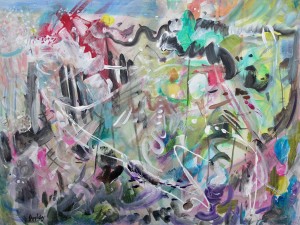An art collector asked me what I thought made a good abstract: “Is there such a thing as abstract being good? Are such paintings just a whim of paint that any child could do?” I said I believed it involved the spaces in between – on canvas and otherwise.
In my mind to truly investigate abstraction is to go deep into oneself and employ every aspect of ones intellect and emotion; this may look child-like but isn’t. A painterly maturity is necessary. For one thing one must be courageous enough to take the criticism that will undoubtable result. The dissatisfaction in the artist creating the work may be the first attach to overcome.
In any case, I found that accepting my own abstracts was like accepting idiosyncrasies in people which actually made them interesting and full of life. The supposed imperfections, spontaneous brushwork with or without a brush, broken rules of design, ambiguous colour coordinations, lines that do not outline and the spaces in-between, all may seem vague in their purpose. Sure this handiwork can be “fun” but often can also be a painful process too, of giving and letting go, where the boundaries of the canvas cannot contain the whole of it all.
The reality is that there is no understanding abstraction fully and the mystery of it perhaps is what makes it appealing.
The abstract painting is often unexplainable and unexplained, hanging alone amongst a series of works left to experience what people see in it – if anything.
For me abstract is the most freeing method of painting and makes me feel like a child. But it also makes me feel the most involved, mature and alive.
I share Picasso’s Quote: “A painting is never more alive then when it is viewed.”
May we too live fully because of the “abstract” around us. Happy New Year! Jane


An inspiring and insightful blog post!